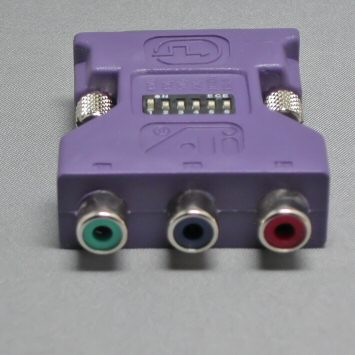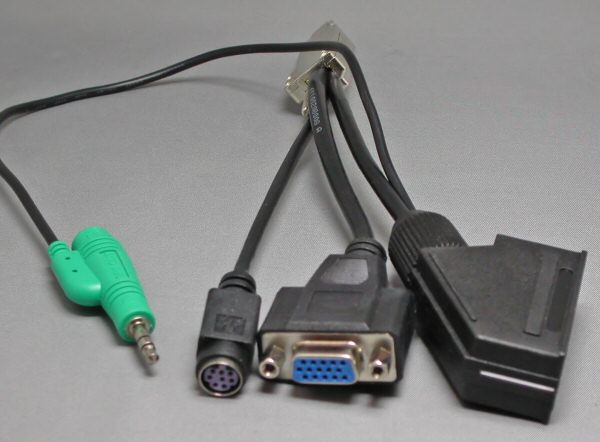Connectivity and breakout box
Analogue composite and S-video come in along with L/R audio via a supplied mini breakout box (okay, breakin box) that has a captive lead about four feet in length. That plugs into one of the three socket extensions on a special (and, of course, supplied) dedicated adaptor that goes into the card's miniature multi-function socket. Look at the pic below and you'll see a bunch of black domino-look nobbles on the top of the breakout box. These are matched by holes on the bottom of the box, the idea being that you can neatly stack a number of adaptor boxes, rather than having them all flapping about in the breeze.
Dominos, but not as we know them
- the video/audio in box
The dedicated socket and adaptor will take a lot of words to describe, so rather than out attempting that, we suggest you look at the pictures below. If you've seen recent All-in-Wonder cards, you'll notice that ATI has carried over the design from them. All we would say is that it pushes home quite easily; can be used (only by reviewers and pre-viewers, though) without bothering to tightening up that one long, single fixing screw that you might just be able to make out.
ATI seems to specialise in coming up with unusual small video/monitor socketry for its All-in-Wonder cards - the better to save to save space presumably. The trouble with that, though, is that you can't just dive out to a computer store on a weekend and buy one if the dog has chewed up the original. Indeed you might end up only being able to buy it on the net from a special ATI-dedicated store where prices of most cables and adaptors seem reasonable. Delivery, though, can be a bit slow if choosing the free non-express air-mail option. So why did we never replace the weirdo 29-pin adaptor that our All-in-Wonder Radeon 9600 PRO came with and which is attached by only one screw when it should have two? Well, there are different schools of thought on this, but $40 seemed to us to be too much to pay for one screw. Cough!
Note the
tiny multi-function socket between the TV aerial-in socket and DVI port.
Note also that the FM radio input at the left is of an identical female design to
the TV input. That made it a bit hard to plug in the supplied
T-wire aerial, on account of it having a female connector, too
Note also that the FM radio input at the left is of an identical female design to
the TV input. That made it a bit hard to plug in the supplied
T-wire aerial, on account of it having a female connector, too
ATI provides three levels of video output quality. As well as composite video and its superior, RGB, the card can also bung out even higher quality component video. This comes out via the DVI socket and uses the dongle below which is fitted with three phono jack sockets.
The point about having component, though, is that it's used to feed an HD-compatible TV set or HD-compatible PC monitor. And this, ATI says, is what people will really be wanting - and we tend to agree. Unfortunately, we weren't able to try the HD output - and we'll get to the excuses soon enough.
The
green plug has to go in the PC's sound input socket
or there's no sound from
the AIW. Next along is the shared input for S-video, composite video and L/R audio. After
that is the VGA socket, followed by a Scart socket feeding out RGB and composite video.
Oh, and all go to a special adaptor seen in the background pointing away from the camera
the AIW. Next along is the shared input for S-video, composite video and L/R audio. After
that is the VGA socket, followed by a Scart socket feeding out RGB and composite video.
Oh, and all go to a special adaptor seen in the background pointing away from the camera















